Trentino Alto Adige, also known as Trentino-South Tyrol or Südtirol, is an autonomous region in Northern Italy located in the Alps. The capital city is Trento, and the region covers an area of 13,607 km2 with a population of around 1.1 million. With its combination of Alpine peaks, green valleys, lakes, medieval castles, and modern cities, Trentino Alto Adige offers stunning natural scenery and a fusion of Austrian and Italian cultures. The current president of the autonomous region is Maurizio Fugatti since 2021. The South Tyrolean People’s Party has dominated regional politics since the 1940s, reflecting the German-speaking majority in South Tyrol.
Where is Trentino region located in Italy?
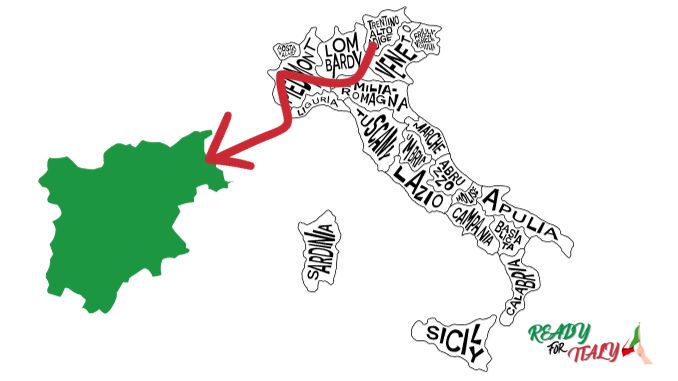
Trentino Alto Adige is situated in the northernmost part of Italy, in the central section of the Alps. It is Italy’s fifth smallest region but also one of the most culturally and geographically diverse.
To the north and east, it borders Austria, specifically the Austrian states of Tyrol and Salzburg. To the west, it borders the Swiss canton of Graubunden. Within Italy, it borders Veneto to the south, Lombardy to the southwest, and Emilia-Romagna to the west.
The northern location and extensive mountain ranges like the Dolomites isolate Trentino Alto Adige from the rest of Italy. This has allowed it to retain a distinct regional identity and culture different from other parts of Italy. Its history of rule by the Austro-Hungarian Empire and South Tyrol’s status as a majority German-speaking province give it closer ties to Austria and Switzerland.
The primary airports serving Trentino Alto Adige are Innsbruck Airport in Austria to the north and Verona Airport to the south in the Veneto region. Smaller regional airports include Bolzano Airport and Trento Airport. The region is well-connected to Italy’s railway network, with main train stations in Trento, Bolzano, and Merano. Bus networks operated by SAD, Trentino Trasporti, and SASA also connect towns and villages across steep mountain roads.
Where is South Tyrol located in Trentino, Italy?
South Tyrol, also referred to as Alto Adige in Italian or Südtirol in German, is an autonomous province in the northern part of Trentino Alto Adige bordering Austria and Switzerland.
It is Italy’s northernmost province, and the majority of its population speaks German as their first language. The capital and largest city is Bolzano, known as Bozen in German.
South Tyrol covers 7,400 km2, forming around 54% of the total land area of Trentino Alto Adige. It stretches from the peaks of the Dolomites mountain range in the east to the Ortler Alps in the west. The Adige River flows from the valley of Vinschgau/Val Venosta near the Swiss border southwest towards Bolzano.
To the north and east, South Tyrol shares an international border with Austria, in particular the Austrian state of Tyrol. To the southeast of Italy, it borders the Italian-speaking Trentino province and Belluno in the Veneto region. Trentino forms a territorial “wedge” that nearly divides South Tyrol into two separate parts.
What is the population of Trentino, Italy?
According to the latest official statistics from 2023, the total population of Trentino Alto Adige is approximately 1,075,317 people. Trentino province has around 543,450 residents, while South Tyrol province has around 549,737 residents.
The population density is quite low at 80 people per square km but unevenly distributed. While South Tyrol has a lower total population, it has a higher population density of 82 people per square km compared to 78 people per square km in Trentino. Mountain valleys and urban centers have higher densities than rural Alpine areas.
Bolzano is the largest city and provincial capital of South Tyrol, with a population of 106,107 residents within the city proper. Trento is slightly larger overall, with a municipal population of 118,046 residents.
Compared to Italy as a whole and many other regions that have recently experienced declines, Trentino Alto Adige has positive demographic growth. Its population has increased by over 5% between 2010 and 2020 due to positive natural growth and immigration. Tourism also increases seasonal populations. An estimated 11.5 million tourists visit Trentino Alto Adige each year, according to statista.com.
Map of Italy trentino alto adige
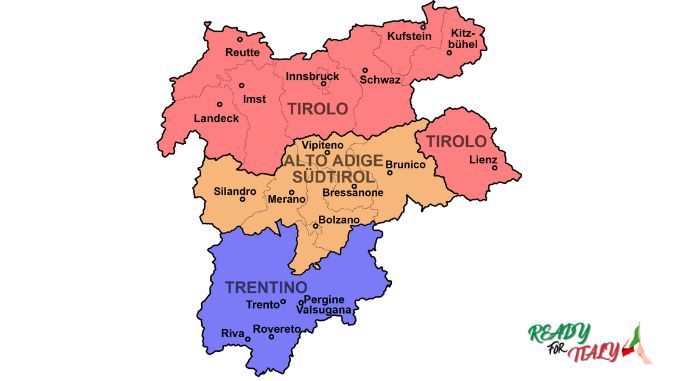
South tyrol map
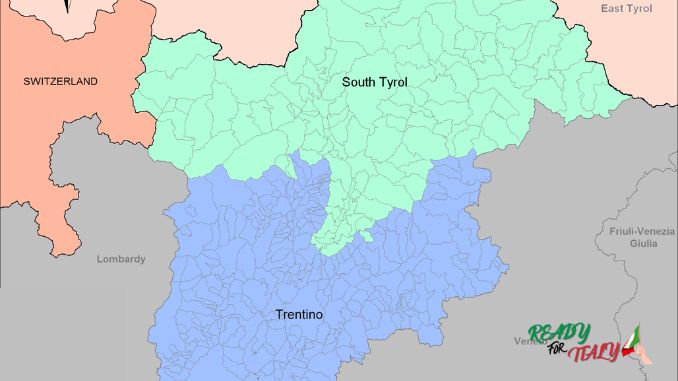
What are the Geographical features of Trentino alto Adige?
With a total area of 13,607 km2, Trentino Alto Adige is dominated by mountains, valleys, and lakes. The varied terrain and biodiversity supports diverse ecosystems and makes it famous for outdoor tourism. Over a third of the region is protected through parks and reserves.
The most defining geographical feature is the Dolomites mountain range, part of the Southern Limestone Alps. They cover the northern and eastern sections of the region, including almost all of South Tyrol. The Dolomites are renowned for their jagged sawtooth peaks and sheer cliff faces made of pale-colored limestone and dolomite rock.
Major valleys carved between the mountain ranges include Val d’Adige, Val di Non, Val di Sole, Val d’Isarco, and Val Pusteria. These valleys provide crucial agricultural land and transportation routes to connect settlements.
Large lakes include Lake Garda, Lake Braies, and Carezza Lake. These glacial and riverine lakes located at different elevations provide habitats, drinking water, and recreation. The varied elevations, soils, and microclimates support diverse flora like mountain pines, holly, mushrooms, and wildflowers and fauna including ibex, chamois, marmot and eagles.
Dolomiti
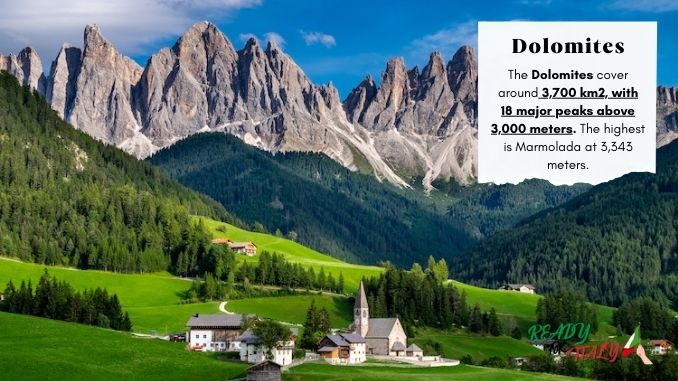
The Dolomites are a mountain range located in northeastern Italy, mainly within the provinces of Trentino Alto Adige as well as smaller sections in Veneto and Friuli. They form part of the Southern Limestone Alps and were designated a UNESCO World Heritage Site in 2009.
The Dolomites cover around 3,700 km2, with 18 major peaks above 3,000 meters. The highest is Marmolada at 3,343 meters. They were formed from coral reefs and marine life fossils dating back 200 million years ago, which were then lifted and eroded by glaciers, rivers, and weathering.
The Dolomites derive their name from the French geologist Déodat Gratet de Dolomieu, who, in the late 1700s, studied the unusual calcium magnesium carbonate rock that composes the peaks. The mineral dolomite was later named after him. The mountains display sheer vertical walls and towers with gray, pink, and pearl-colored bands.
The Dolomites provide spectacular vistas for hiking, climbing, skiing, and paragliding. Famous landmarks include the Tre Cime di Lavaredo peaks, the contorted limestone towers of the Sella Group, and the vast vertical gorge of Marmolada. The region has a high density of mountain huts, cableways, and ferrata climbing routes to experience the terrain.
What are the most Famous Cities to Visit in Trentino alto adige?
Based on visitor numbers, popularity, and attractions, some of the most famous and must-see cities to visit in Trentino Alto Adige include:
Bolzano
Bolzano is the capital city of South Tyrol province, with around 107,436 residents. It attracts over 2 million tourists annually who are drawn to its picturesque medieval old town, vibrant culture blending Italian and Austrian influences, fascinating museums, and surrounding scenery of vineyards and the Dolomites.
Major attractions of Bolzano include the Gothic cathedral, the archeological museum displaying the preserved body of Ötzi the Iceman, the Dominican Church, Hofburg’s former Imperial palace, the Cableway to Renon plateau, and the unique arcades and frescoes of the medieval city center. The city is bilingual in both German and Italian.
Merano
Merano is a popular spa town and health resort situated on the Adige River with around 35,119 residents. Its mild climate, gardens, castles, and spa facilities attract nearly 1 million visitors per year.
The attractions of Merano’s beautiful historical center include the Gothic St. Nicholas’ Church, the arcades of Via Portici Street, and the Thermal Baths. The surrounding region offers botanical gardens, juice groves, vineyards producing the red Teroldego wine, and mountain views, including the Tappeiner Promenade.
Trento
Trento is the capital city of Trentino province and the largest city in the region, with around 118,363 inhabitants. Set in a wide valley surrounded by vineyards and mountains, Trento combines a modern outlook with historic architecture and an ancient past.
Top attractions of Trento include the Roman ruins, medieval Castello del Buonconsiglio fortress, Cathedral of San Vigilio, frescoed historic palaces, and museums displaying antiquities, alpine archaeology, and art. Within the city are walking trails along the Fersina Creek and up to hilltop viewpoints. Trento sees around 750,000 tourists every year.
Rovereto
Rovereto is a small city with around 37,549 residents located 20 km south of Trento. It receives around 750,000 visitors annually drawn to its compact historic center, important museums, and surrounding scenery.
Places to see include the bell tower Torre Civica, Museo della Guerra detailing World War 1 history, Depero Futurist House museum, and Venetian palaces. The nearby hills and Lake Garda provide a beautiful setting for cycling, walking, and relaxing in cafes.
Bressanone
Bressanone, also called Brixen in German, is a picturesque town of around 22,728 inhabitants in South Tyrol along the Isarco River. With around 1 million annual visitors, its main attractions are the beautiful medieval facades, Baroque cathedral and cloister, Hofburg palace, and mountaineering museum.
The Alpine town is surrounded by vineyards and orchards in the valleys leading up to the imposing Dolomites peaks. Bressanone has an important artistic and cultural heritage in its churches, musical history, and frescoes. It hosts regular festivals, concerts, and markets in its atmospheric cobblestone streets.
Brunico
Brunico is a charming historical town of around 16,978 inhabitants located 40 km northeast of Bolzano in South Tyrol. Surrounded by the majestic mountains of the Pustertal Valley, Brunico sees around 250,000 visitors annually.
The quaint medieval quarter is still surrounded by ancient city walls and watchtowers. Sights include the fortress-like Prince’s Palace, frescoed houses, Gothic churches with ornate carvings, and views of the mountains. The town serves as a gateway to the Val Pusteria and Dolomites for hiking, cycling, and winter sports.
Canazei
Canazei is a scenic mountain town of under 5,000 inhabitants situated at 1,450 meters elevation in the heart of the Dolomites range. Surrounded by incredible views and ski slopes, it is a popular base for hiking, climbing, and skiing.
This tourist destination in the Fassa Valley receives around 500,000 annual visitors attracted by the Alpine ambiance, shops, restaurants, and easy access to lifts ascending the Sella, Marmolada, and Pordoi massifs. Activities include mountain biking, rock climbing, downhill skiing, and après ski.
Malè
Malè is a small alpine town of around 4,800 inhabitants located in the upper Val di Sole at an altitude of 850 meters. Set within the Brenta Dolomites peaks, it serves as a hub for outdoor sports, receiving about 500,000 tourists annually.
Attractions include its pretty historic stone houses and churches framed by mountain views. In winter, Malè is a center for skiing areas like Madonna di Campiglio via cable car access. Other activities include hiking, mountain biking, rafting, paragliding, horseback riding, and rock climbing.
What are the safest cities in Trentino alto adige?
Some of the top safest cities and towns to live in Trentino Alto Adige, according to crime statistics and safety indexes, of italy istat, include:
- Rovereto – Has the lowest crime rate in the region, and only 58 crimes reported per 10,000 population.
- Arco – Historic lake town with extremely low crime due to its small population of 16,000.
- Cavalese – Small medieval village popular with climbers and very safe.
- Cles – A rural town of 7,000 people situated in the valleys of Western Trentino.
- Pergine Valsugana – Provincial town with only 63 crimes per 10,000 inhabitants.
- Mezzocorona – Vineyard town near Trento with hardly any crime.
- Levico Terme – Popular spa town and one of Italy’s safest municipalities.
- Mezzolombardo – Agricultural and industrial town near Trento with few crime incidents.
These rural towns and small cities all report very little violent crime and benefit from strong community ties, engaged local police, low unemployment, and tourists who deter opportunistic crimes. They offer safety and a high quality of life.
What are the most dangerous cities in Trentino Alto Adige to Visit?
While Trentino Alto Adige has an overall low crime rate compared to other parts of Italy, the most dangerous cities to visit based on slightly higher reports of petty theft include:
- Bolzano – The capital city sees more pickpocketing and backpack thefts due to high volumes of tourists, especially around the train station. Still enjoys low violent crime.
- Trento – Has experienced some petty crimes in crowded tourist sites. Remains very safe by European standards, with 130 crimes per 10,000 people.
- Merano – Spa town has seen minor theft targeting tourists—very limited violent offenses.
- Riva del Garda – A busy lakeside town has pockets of opportunistic tourist theft. Few violent crimes occur.
These cities attract millions of visitors yearly, so petty theft is more likely to occur at crowded sites, transportation hubs, and nightlife areas. Violent crime rates are still extremely low. Exercising basic street smarts will minimize risks. Smaller towns and rural areas have negligible crime rates.
What is the Best Time to Visit Trentino Alto Adige Region in Italy?
The best time to visit Trentino Alto Adige depends on the type of trip, activities, and weather conditions sought:
Summer (June-August)
Summertime brings warm, sunny days perfect for hiking through alpine valleys and wildflower meadows. Mountain hut restaurants and towns are lively with cultural events. Daytime temperatures average 20-30°C, but it cools at night. Thunderstorms can occur. Prime season leads to higher accommodation prices.
Fall (September-October)
Fall offers beautiful scenery as larch and deciduous trees turn golden colors. Days are sunny and mild, while nights are cool. Temperatures average 15-20°C. It’s ideal for harvest festivals, mushroom foraging, mountain sports before winter, and fewer crowds.
Winter (November-March)
The coldest months offer snow-covered landscapes perfect for skiing the slopes of hundreds of resorts, going on snowshoe walks, and Christmas markets. Average temperatures are below freezing, but sunny days can warm up. Expect cold nights below -10°C at higher elevations.
Spring (April-May)
In spring, wildflowers bloom as mountain valleys thaw and temperatures climb to 10-15°C on average. Melting snow swells rivers for whitewater rafting. Spring is great for hiking, biking, rock climbing before peak season, and seeing baby animals.
At higher mountain elevations, temperatures can be 10-15°C colder than valleys year-round. The region experiences some regional climatic variation. Inner valleys like Vinschgau are dry, while mountain areas get more rain and snowfall.
What is the traditional food of Trentino alto Adige?
The cuisine of Trentino Alto Adige combines the hearty, meaty dishes of Austria and northern Italy with local Tyrolean and alpine specialties using fresh regional produce. Some traditional and specialty foods include:
- – Speck – Smoked and salted ham, especially South Tyrolean Speck Alto Adige PGI.
- – Canederli – Flour, egg, cheese, and bread dumplings, often served in broth.
- – Strangolapreti – Spinach and bread dough dumplings similar to gnocchi.
- – Carne salada – Salted and cured beef, especially from cows in Val di Non.
- – Polenta – Cornmeal boiled into thick porridge and topped with stew or cheese.
- – Spätzle – Little hand rolled or pressed egg noodles.
- – Knödel – Bread or potato dumplings served in soup or with meat.
- – Goulash – Spicy beef stew seasoned with paprika.
- – Saurkraut – Finely shredded and fermented cabbage.
- – Sachertorte – Chocolate cake with apricot jam filling.
- – Kaiserschmarrn – Shredded pancake with raisins, often served for dessert.
- – Apple strudel – Flaky pastry with apple filling.
Traditional restaurants can be found across cities and villages. Farmhouse inns called Maso serve hearty meals. The region produces quality cold cuts, cheeses like Asiago, and beer like the Forst brand.
What are the most famous Trentino alto adige wine brands?
Trentino Alto Adige produces some of Italy’s most acclaimed white wines and sparkling wines due to the Alpine climate, high elevations, and mix of volcanic and glacial soils. Some notable labels include:
- Cantina Ferrari – The most eminent Trentodoc sparkling wine producer. Their vintage bottles are Italy’s answer to French Champagne using chardonnay and Pinot Nero.
- Alois Lageder – Biodynamic winemaker in Alto Adige known for layered whites like Pinot Grigio and Gewurztraminer from single vineyards.
- Foradori – Visionary winemaker Elisabetta Foradori makes terroir-driven reds like Teroldego and whites. Based in Trentino.
- Girlan – Specializes in elegant Pinot Nero and Chardonnay wines grown on the steep slopes around Lake Caldaro.
- Elena Walch – Major exporter crafting bold native and international varietals like Lagrein, Pinot Grigio, and Beyond the Clouds blend.
- Cantine Terlano is a prestigious producer of white wines located in the town of Terlano in South Tyrol, Alto Adige. It is a cooperative winery founded in 1893, representing 150 locals.
- Terlano vineyards-Terlano focuses on single-variety white wines that express the Alpine terroir. Their flagship wines are made from Pinot Bianco, Chardonnay, and Sauvignon Blanc. These whites are known for their elegance, complexity, and minerality from the porphyry, gravel, and clay soils.
- Pojer & Sandri – Traditional sparkling wines made using méthode Classico from cool climate vines around San Michele Appiano.
- Franz Haas – Prestigious Schiava, Lagrein, Pinot Nero, and Moscato from Alto Adige vineyards since 1880.
- Cantina Andriano – Quality co-op making expressive wines like Pinot Grigio and Nosiola from Trentino vineyards.
- Castel Sallegg – Historic estate in Caldaro producing mineral-driven Pinot Bianco, Pinot Grigio, and Sauvignon.
- Cantina Tramin – Top co-op crafting terroir-expressive single vineyard Gewurztraminer in Alto Adige.
The wines are noted for vibrancy, complexity, minerality, and precision, expressing the Alpine terroir. Many wineries emphasize sustainable practices and terroir integrity. The region combines winemaking tradition with innovation.
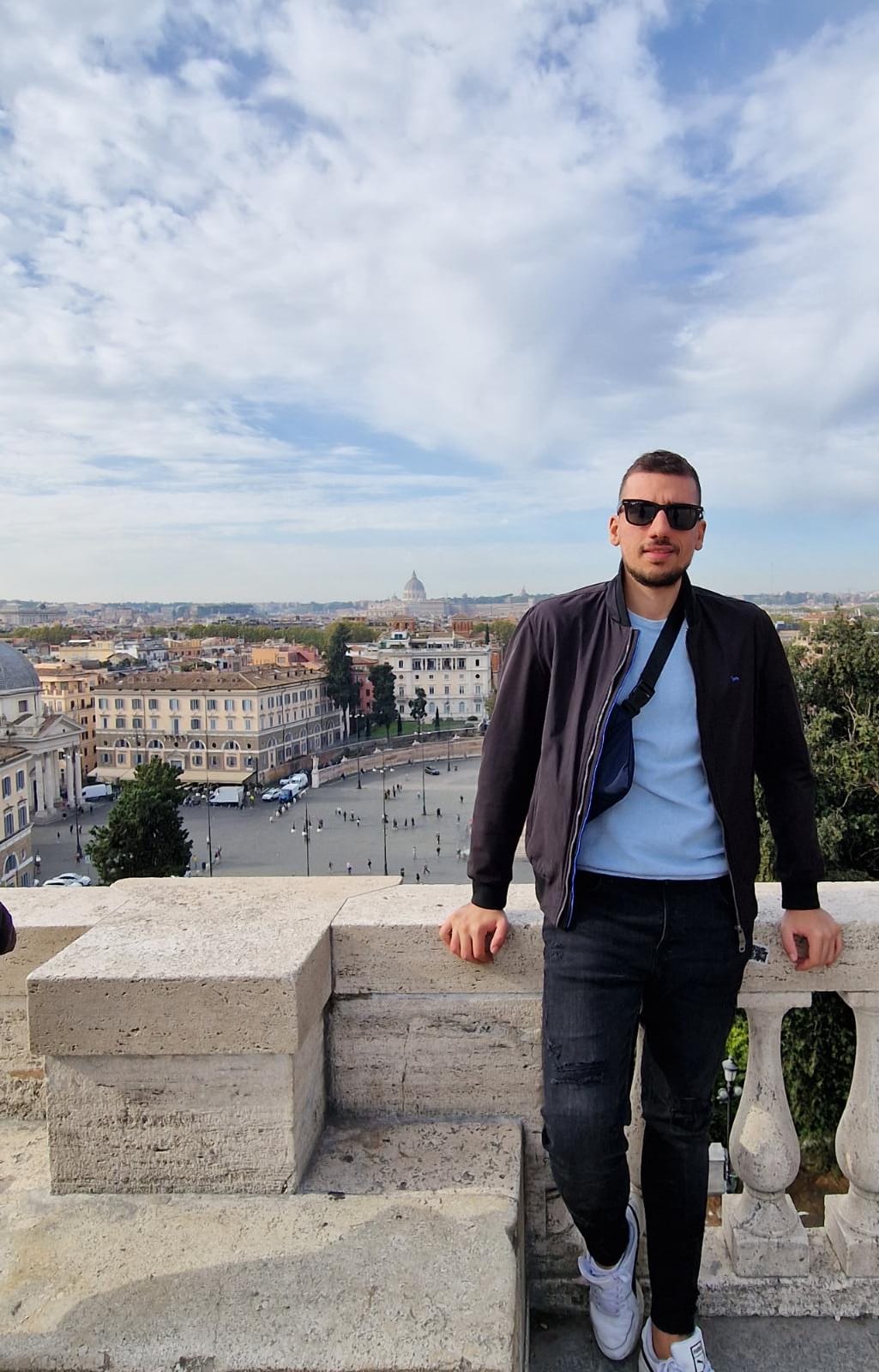
Hey, I’m Giovanni, an Italian that lives in Italy and the author of this website! I started this website because I like to travel, discover new places and share my knowledge about Italy with more people worldwide. I love writing about everything regarding Italy, its culture, history, and lifestyle. I hope you found value in whatever article you read, and if you have any remaining questions, don’t hesitate to contact me!
